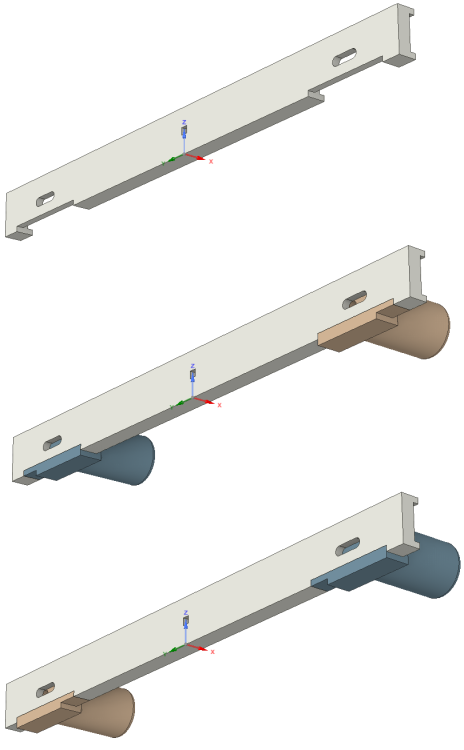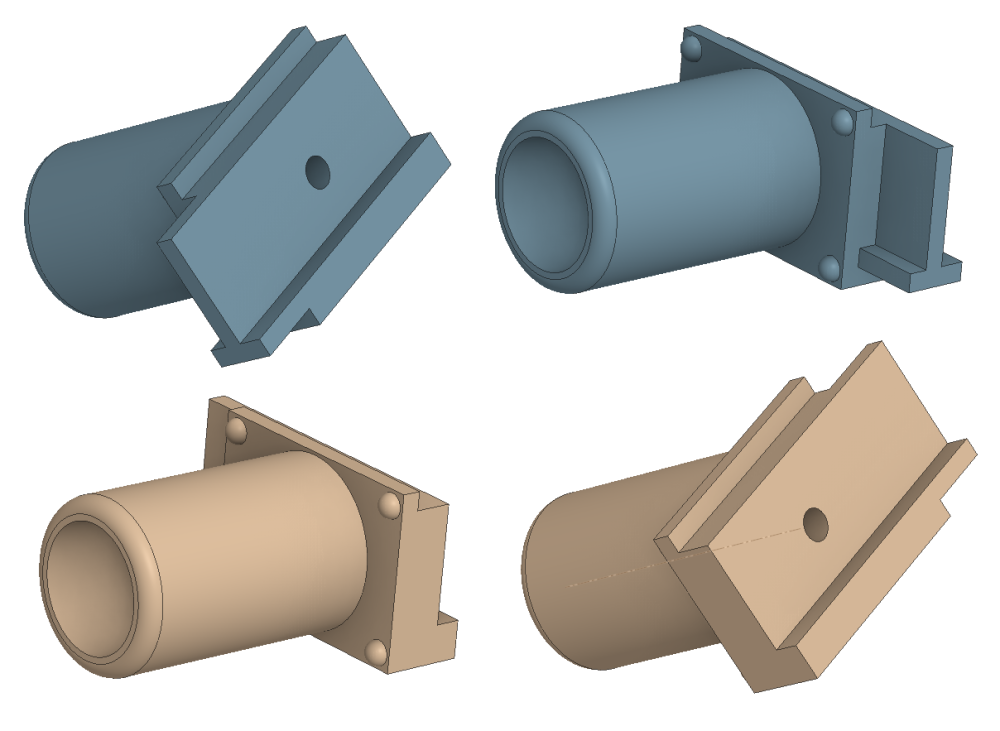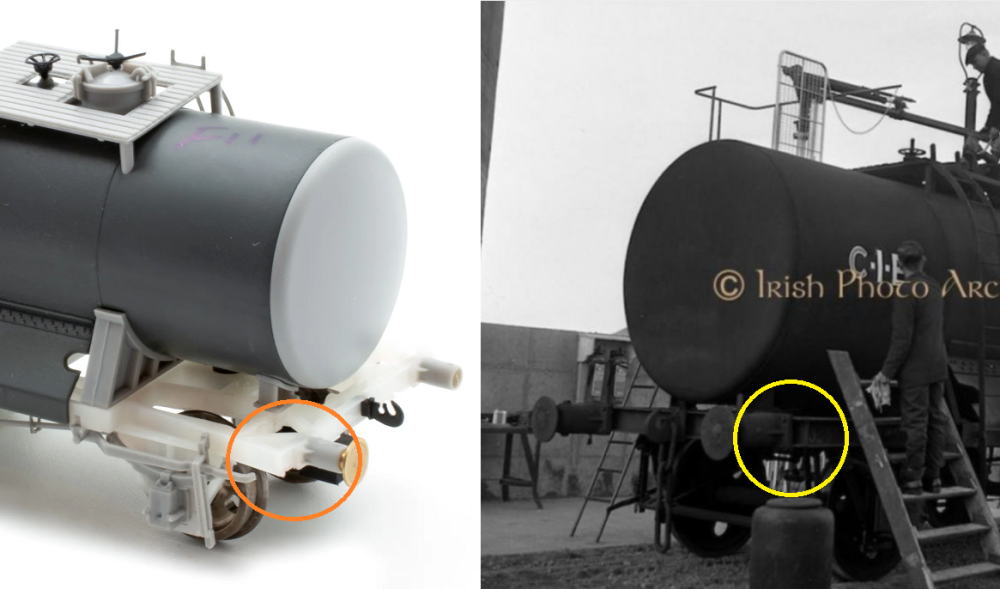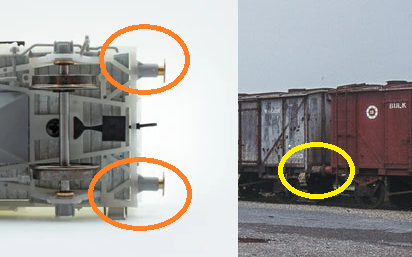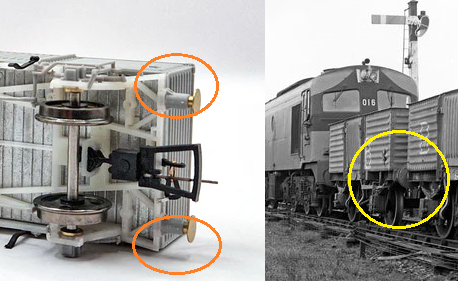-
Posts
51 -
Joined
-
Last visited
Recent Profile Visitors
The recent visitors block is disabled and is not being shown to other users.
MAL's Achievements
-
I think about to cut the buffers and mill the beam. The bulleids need to be fixed in a jig I have to build to avoid unneccessary damages. The only problem I have is that I have not yet found buffers as detailing parts (white metal or such) which are British/Irish enough and 1/76 scale to be mounted in wide spacing. My knowledge about detail parts and sources is 90% US and 10% Germany. Does anyone know a source of buffers that would look good enough to be applied to the bulleids? THey do not need to be 100% accurate but should be of a good size and similar shape. The 1/87 buffer I have here are a bit too tiny and look too German or completely different. Any hint will be appreciated. Thanks in advance
-
I first thought to include the doubled holes for all the brake rigging into my sketched design. But then I decided to keep this for later. Mainly because I would have to draw the remaining frame instead of just the end beam.
-
This is an idea I had how the models could have been made to fit both IR and BR buffer spacing. I made a very rough 3D sketch to show the idea. Some details will have to be improved and adjusted to make the idea feasible for molding and assembly. I thought to have buffers as extra parts to be either applied by the customer (one item for all) or applied at the factory (which would make 2 different items for either IR or BR). My first idea was to have one buffer&baseplate with a 1.15mm but assymetrical extension on one side. The buffer beam (is this the right wording) has room to take the buffer mounted to the inside (BR spacing) or the outside (IR spacing). Checking the Bulleids models I saw the buffer center are offset by 0.15mm (you can see it on my recent picture I posted last Thursday at 21:37). Therefore I had to make a left and a right buffer. You get IR spacing by placing the left buffer on the left and the right on the right - BR spacing by placing left to the right and right to the left. To show the design I decided to do it with the more simple buffer of the tank wagon which has no reinforcing ribs. Maybe this idea might find its way into other new toolings (we all need brake vans ) or into a re-run of the bulleids somewhen in the future. --- --- ---
-
(OFFTOPIC) I wrote: I just converted a Kato DD51 (JNR) into a kit by touching the loco with the caliper while measuring the Craven and the Mark 2D. The level of tracks was 125 cm and the drop of the Kato engine was hard. All parts seem to be fine but apart. Lucky that Kato uses a good plastic material and that the loco was only one year old. My other DD51 is from 1995 or so. Details of the kit coversion will be checked later. Now I checked the damage of the 125cm drop (equivalent free fall over a prototypical 100m down to the ground). Some snap hook were cracked - could be glued. 2 stirrups, front and rear on one side were broken - might be able to glue - at least good for the rear side in display case. One bogie is broken apart and one side frame lost it's guide and snap pin. This is bad as it turns her to spend the remaining live in display case. The broken bogie cannot hold the worm gera and the intermediate gear in place. And the plastic used for bogies is an ugly thing to glue. All these kind of repairs I did before did not last long. Most often less than one operating hour. (now BACK to TOPIC with the next entry)
-
MAL started following You Can't Beat A Bit of Bulleid - Open Wagons Next For IRM
-
You are right, man. It is mandatory to make a jig for mounting the buffers. Otherwise it is as you said. I just experienced the removal isn't that easy as expected. The multiple damages the removal process will leave behind will make the thing even worse.
-
update: I just took my magifier lenses to check the buffer mounting to the frame. To me it seems that the the base plate of the buffer (rectangular with 4 bolts) is part of the frame molding. The "tube" (highlighted in yellow below) with 4 fins seems to be glued to the frame. The buffer itself is a metal part (turned to shape) sitting with a small spring inside the "tube" and fixed by a snap (the little thicker end of turned part) fit via a narrow hole inside the "tube". (sorry. I am fighting to use the correct words). Replacing the buffer would need to toucht the base plate which could not be cut off easily as it sits in an I or C beam. The idea of respacing just became far more difficult as desired.
-
If the buffers are glued it might be easier to remove them and mount them in the right position. I tried to remove one buffer but failed up to now. Buffer is still in place, no broken frame yet. Did you remove a buffer already? Could you suggest a good way to remove the buffer?
-
The buffer spacing is not obvious by the distance but by the visible remaining buffer plate space from buffer to the outside. The 1.25 mm is a huge and easy to spot deviation.
-
Yes you can. I once had been in that 21mm thread at least with one comment. But I think converting a layout to 21 mm is a quite different thing compared to make a rolling stock model to look as the prototype as close as possible. And the thread was about 21mm tracks to ride on. Right now it's about model appearance. But why do we have chassis with wide bearings? Isn't it to have the right impression of the vehicle. Those bearings and bogies are obvious for the shape even that they hold wheelsets of 16.5mm gauge. To me the buffer position is as important as the bearing position. Pairing wide wagons with narrow wagons contrast in bearing position - why do the buffer have to align? Running on a completly wrong gauged track (16.5mm is not correct for 1/76)? The issue cannot be solved easily. Regarding the 21mm thread I think the best solution is a correct 00 model with the capability to use 16.5mm wheelsets as well as 21mm. This is available with some MM and IRM locos as well as with some of the MM and IRM rolling stock. I am really satisfied with these models. And as a compromise I accepted the Dapol, Hornby etc. British based wagons with narrow bearings and buffers. But these should slowly be out dated. The world is turning and things develop (I never thought that I would write something like this). Japanese H0 model railroading is done in 1/80 with a Cape Gauge, 1,067 mm (3' 6”) prototype. Some can be converted to 13mm gauge and also some H0j raises with 1/87 scale and 12mm tracks. It aslo is a comromise that slowly moves to be prototypical (at least some parts). PS: Please excuse if I sometimes use terms usually used with US railroads. US rails was my main interest since 1990. PPS: I don't want to be offending even if some phrases may appear to be. English is not my mother's tounge.
-
I suggest to make an investigation about what should be produced claiming to be up-tp-date. Couldn't you start a survey to find out. Especially as up-to-date seems to be a wide wheels set capability (MM 121, 141, 181, IRM Irisch rolling stock).
-
I thought the development with Irish rolling stock already was on the point to have all main dimensions correct. At least the bearings to be able to take the widened wheelsets. The flats, ore and other IRM 4 wheelrs and the A class are this way. My MM Cravens and the Mark 2Ds have 25mm spacing. The Cravens will get the wide B4 bogies to give the impression they couldn't provide up to now. So I really did not expect the Bulleids to have the narrow buffer spacing. Sad that IRM missed this opportunity to be on top. I just converted a Kato DD51 (JNR) into a kit by touching the loco with the caliper while measuring the Craven and the Mark 2D. The level of tracks was 125 cm and the drop of the Kato engine was hard. All parts seem to be fine but apart. Lucky that Kato uses a good plastic material and that the loco was only one year old. My other DD51 is from 1995 or so. Details of the kit coversion will be checked later.
-
I thought I might regauge the wheel sets somewhen and have a few meters of broad gauged track just for display. But this seems no longer necessary as long as the buffers are narrow. I am a little confused now about how to continue with my rolling stock.
-
Hi Fran It was good to write the lines here in the forum. Otherwise I had focused on this issue without notifying the other identical issues. The bad thing is the Bulleids have these tiny buffer plates which emphasize the flaw. Anyway - I'll open a can of Guinness (the cans with the small plastic ball inside carrying pressurized nitrogen to make the right texture of Guinness in the glass) and then think and decide. Model railroading is a endless story of compromises. Cheers!
-
Hi Fran this is good bad news to me. I didn't notice this befor and probably had not noticed the issue if I had selected a 141 or 181 to pull the sting of my Bulleids. The broad buffer plates of the 42' flats covered the different buffer spacing well as they did with the 121-181 pairing. At least up to now. With knowing the issue it never is as it was before. A solution for my bulleids could be that all wide buffer spacing locos are forbidden to draw the BR buffer spaced wagons. But there is still the distorted impression of wide bearings and narrow buffers. Sad story that this happened with these otherwise really nice IRM models. To solve the issue I would need to cut all buffers off and move each of them 1.25mm to the outside. There are 72 buffers to be moved + 84 buffers on preordered vans and grains. This will probably give me a lot of broken bulleids (at least bulleid with broken details) and a lot of cuts in my fingers. What should I do? Return and cancel, improve or keep them and drown the pain in Guinness?
-
This weekend I came across that issue when placing a 121 class in front of my bulleid open string. By this I realized what distracted me on these really nice opens and also the just arrived tank wagons. Comparing with images of the prototype I could prove the reason is the narrow buffer spacing I mentioned in my mail before. Double checking with an IRM ore and a 42' flat it became obvious the Bulleids Triangular frames suffer from a buffer spacing mismatch. Looking for some information I found that in 1887 the Railway Clearing House (RCH) set the dimensions to those still valid today: Buffer spacing (from buffer centre to buffer centre) = 5 feet 8 inches (1727 mm, 1:76 = 22,7mm) with standard gauge. On Irish broad gauge the buffer spacing is 6 feet 3 inches (1900 mm, 1:76 = 25mm). I picked some older models (British rolling stock by Dapol paited to appear Irish) I had stocked somewhere in the rear of my attic. I saw the IRM Bulleid buffer spacing aligns with the models of British prototypes. Then I checked more images of prototype and compared to available model images. This was disappointing. Carefully looking at these images one can see the narrow buffer spacing on all of the early undecorated models of flats, opens, tank and even the grains and vans seems to have the british spacing. I was so happy with the beet traffic opens I recently got and now ... ... ... ... ... ... ... For example compared wagons: I took the image sections from images in other threads of this forum as well as from the IRM announcment of the bulk grains. Deeply hoping this will be o.k. here in the forum.
.png.c363cdf5c3fb7955cd92a55eb6dbbae0.png)




